
The Eutetrapleura interradialia are materialized in the Tetracorallia (also known as Rugosa). They are extinct corals (?Cambrian--Lower Trias). The skeleton of a single rugose coral is more or less conical and contains a polyp. It is radially partitioned by septa, which also are skeletal elements and which reflect the global structure of the polyp. See the next Figure.

Figure 1. (d) Amplexizaphrentis (Carboniferous) with part of epitheca removed (ca. x 2). (e) septal emplacement shown by serial sections taken through marked level.
C cardinal septum, K counter septum, KL counter-lateral septa, A alar septa.
( After CLARKSON, E., 1980, Invertebrate Palaeontology and Evolution)
Because the younger skeletal features of the developing coral are not resorbed, they remain visible in transverse sections, documenting in this way the development of the septa. See next Figures.

Figure 2. Diagram of the septal emplacement in a Tetracorallia calyx representing a developmental (concerning individual development) stage comparable to the fifth stage depicted in the previous Figure. 1, 2, 3 Primary septa. C Cardinal septum.
K counter septum. A alar septa. a, b, c secondary septa.

Figure 2a. The same as above. The four a n t i m e r s are indicated by colors. The upper left and right antimers are symmetrically equal, they differ from the lower left and right antimers which are also symmetrically equal. The directional axes are interradial. The main axis of the coral is heteropolar. So the b a s i c f o r m of the coral is that of the Eutetrapleura interradialia.
The situation in the above Figure, concerning septal emplacement in Tetracorallia, is such that the second directional axis (and also the directional plane in which it is contained), i.e. the left-right axis, is bent. This is however immaterial and we interpret this configuration according to the next Figure :

Figure 2b. Promorphological assessment of the situation (regarding Tetracorallia) of Figure 2a : Depicted is the base of the trapezoid-pyramid representing the Eutetrapleura interradialia. Four antimers. The directional axes, represented by red (straight) lines, are interradial.
When the rugose coral Amplexizaphrentis (See especially Figure 1) is very young a single proseptum (i.e. a primary septum) divides it, soon becoming separated into cardinal (C) and counter (K) prosepta. Two other of prosepta follow : the alar (A) adjacent to the cardinal septum, and the counter-lateral (KL) (3 in Figure 2 and 2a). Even at this stage some bilaterality is evident, which becomes more pronounced when the metasepta (secondary septa) are inserted in four quadrants only, on the 'cardinal' side of the alar and counter-lateral septa. Through differential growth the counter-lateral and alar septa move towards the counter septum to make room for new metasepta. Eventually, when more metasepta have been inserted, short minor septa (second-order metasepta) are laid down between the first-order metasepta. Around the cardinal septum there is a cardinal fossula where metasepta are not inserted, and especially during the intermediate growth stages there are lateral (alar) fossulae as well. These are visible in the adult Amplexizaphrentis, but in large Rugosa where the major and minor septa have proliferated greatly the fossulae are so compressed as to be hard to distinguish (CLARKSON, Op. cit.).
The counter-lateral septa do not, in later stadia, distinguish themselves from the subsequent septa. The addition of subsequent septa is not regularly cyclical, but in such a way that in the quadrants between the alar septum and cardinal septum the new septa, as they extend from the margin, diverge from the cardinal septum and converge towards the alar septa (See Figure 2). In the quadrants between the alar septa and counter septum (in fact between the alar septa and the counter-lateral septum) they always diverge from the alar and converge to the counter septum (in fact to the counter-lateral septa). The result is a feather-like positioning : a complete feather at the cardinal septum and half a feather at the alar septa. In virtue of intercalation of more septa, and in many forms also in virtue of division, originates a not wholly regular feather-like positioning ( POMPECKJ, J., in Handwörterbuch der Naturwissenschaften, 1912, Volume II ).